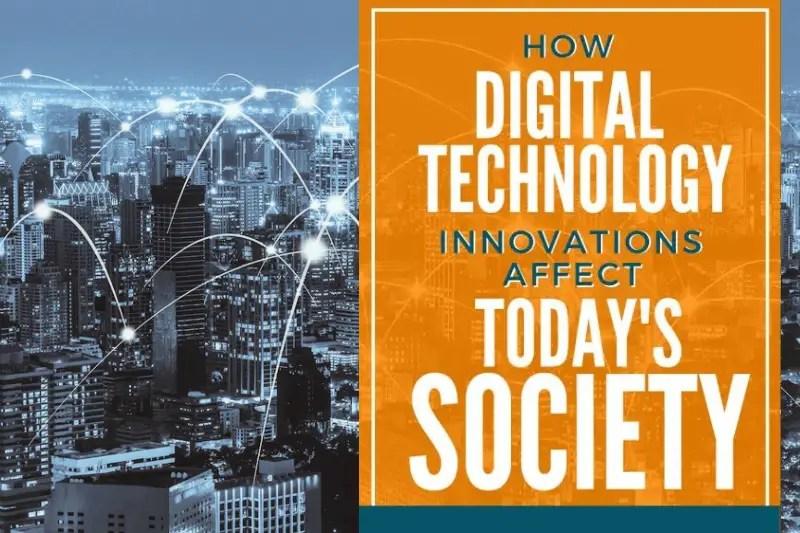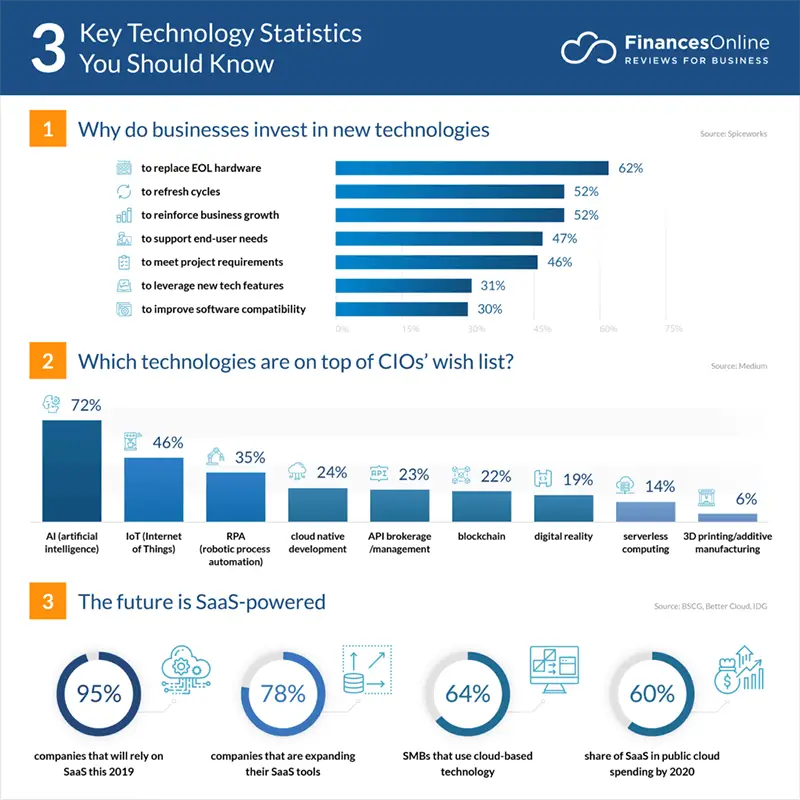Click here to get this post in PDF

Society gives purpose to technology, for technology is made to help man—for better or for worse. From the moment man picked up the first tool in his hand to aid him in his task, to where he is today with all the advancement he has accomplished, technology has always been there at man’s disposal.
The symbiotic union of society and technology has led the world to improvements beyond expectation, and yet, the future still holds an untapped potential for growth, especially in the area of digital technology. The worldwide spending on technology reached $3,360 billion in 2019. (Statista, 2019)
Digital technology advancements continue to permeate every area of our lives. The birth of the computer and ENIAC in 1946 sparked a digital revolution in society that continues to intensify. Digital technology has made our world reachable with its expanding information highways like the Internet and the web. Through it, we have reinvented the way we interact and communicate with emails, conference calls, social media apps, among others. It has improved the lives of students and teachers with digitization in the education sector. It has saved thousands upon thousands of lives with advanced machinery and innovations that have been introduced to the health industry.
We could go on and on, but the baseline is that digital technology and society are in this synergistic relationship that will get stronger as further into the future as we dive deeper into the 21st century.
Let’s look at some of the significant impacts of digital technology on society today.
Impact on Information, Communication and Mass Media
Telephone
Alexander Graham Bell forever changed the way people communicate with his patent on the telephone in 1876. Since then, the first telephones, as well as their modern counterparts, have been advanced by new technology. People can easily talk to anyone in the world, expanding businesses and improving relationships over long distances. Telephone technology integrating with video and Internet has revolutionized calling even further.
Radio
Music and speech were sent across the airwaves by Reginald Fessenden, the father of radio, in 1906. It allowed sound and information to broadcast to a vast audience. It enabled companies to advertise their products globally, and content creators to broadcast news, politics, and vaudeville and sporting events to millions of homes daily. Today, it remains to be a reliable source of music, news and other content anywhere and anytime. Businesses continue to rely on it for affordable, repeat-ad plans to fortify brand recognition with the 271 million people to listen to radio weekly, unbeaten by any medium to date.
Television
Television was made public in 1946 and went mainstream by 1953, reaching 20 million households worldwide. It became the primary source of communication and entertainment to a much broader audience, changed how people perceive the news, and allowed people to be more involved with current events. It influenced the way people live, from the simple choice of clothes to the choice of president. It changed the cultural, sociological and political landscape. It also improved how businesses can advertise their products. It has also been criticized to disrupt traditional values and disperse fake, false, or biased information with the masses.
Big Data
The 20th century saw the first major data project by the U.S. government under Franklin D. Roosevelt’s presidency, when it hired IBM to keep track of the contributions from 26 million citizens and 3 million employers under the Social Security Act of 1937. Colossus was made in 1943 to decipher Nazis’ coded messages during WWII. The National Security Agency (NSA) has been employing thousands upon thousands of cryptologists since the Cold War for intelligence purposes. The first data Centre was also built in 1965 by the U.S. government to store, a single location, over 742 million tax returns and 175 million sets of fingerprints. This project has long been stopped, but it has launched the electronic data storage era.
Digital technologies like data pooling and AI track and diagnose issues in different sectors and industries, or help people perform daily tasks like navigating traffic or online banking. A fine line can exist between the benefits of data technology and its threats. For example, personal data ownership can be empowering, but the unlawful surveillance of governments upon people can be a threat and an invasion of their privacy.
Internet
In 1989 British computer scientist Tim Berners-Lee invented the World Wide Web to facilitate the sharing of information via a ‘hypertext’ system. By 1995, the first super-computer is built, able to do in a second as much work that calculator operated by a single person can do in 30 years. The Internet gave people new ways to communicate, learn, and explore the world at large and allowed computer networks to connect, giving people access to a massive wealth of information. 2010 saw about half of the world’s population have Internet access, compared to only 6% of the people in 2000. With its development, we have seen the rise of email, social networks, newsgroups and video transmission that have connected the world like never before. But as numerous as its privileges are its vulnerabilities, especially on privacy and data protection and overall digital security. Today, even the average users need to be aware of cybersecurity trends and threats to stay protected as they use the Internet.
Digital Media
The Internet has redefined and reinvented mass media. Networks are now making use of all channels and technology they can get their hands to, and the Internet has allowed the digitization of mass media more than possible. Content is now available on-demand, anywhere in the world, in real-time. Digital technology makes digital media easy to create and share. Newer platforms like Netflix, Amazon Prime, and HBO Go. As of date, Netflix has outpaced cable companies in viewers, and other streaming platforms are in close pursuit.
Communication
The advent of microchips launched portable cellular communications. Through mobile phones, users can avail enormous communications capacity anywhere, anytime, in real-time. Although it has brought the world nearer, one of the side effects of never having to “unplug” from the world is that people rarely do unplug. Disruptions in work-life balance are common, and it is now sometimes impossible really to get away from work. These digital communications tools may have made workers more productive, but they also make the employee more connected to the place of work, lessening time for family, health maintenance, leisure activities, and all others that make up for a quality, healthy life. As a result, digital stress has been on the rise, so people need to be more vigilant in compartmentalizing their life to make adequate time for all the things that matter.
Electronic Mail
Today, electronic mail, or email, is the most popular service offered on the Internet. Email is the top preferred method of communication for sending, receiving and storing messages digitally. The Internet administers around 247 billion emails every day. Even in digital marketing, email remains the most effective and cost-efficient marketing strategy despite the popularity of social media ads and other marketing tools.
Social Networks
Social media has taken the world by storm. It’s now easier to connect with other people and expand your social circle. As long as you have an internet connection, you can contact your family and friends, follow their lives unfold in real-time, and record your own life’s events to share with your network. You can find support groups, hobby groups, and even dates through social media, raising connectivity to a new level. Social networks have greatly enabled users to become content-creators themselves. The average person, regardless of who they are, has a chance to be heard and even go “viral” worldwide.
Because of social media apps like Facebook, Instagram, and the like, everyone is findable and reachable. The downside is that everyone is findable and reachable. With more and more minors on these social media apps, people with malicious or even criminal intent have an easier means to find their prey and attack. Users often look for opportunities to grow engagement and sometimes buying fake members does more harm to their social media sites. Cyberbullying and extortion are now rampant. Fake news easily take flight through social media. People have also become trigger-happy in liking, un-liking, commenting and sharing social media content without adequately verifying media sources. It’s as if, if it’s on Facebook, then it must be true. Stricter measures must be set in place, not just with private individuals, but with the app developers and even the authorities as well, to keep social media networks secure. We also need to be vigilant against those that would use social media to reinforce prejudices and sow discord, fueling fragmentation of societies around the world.
Global Culture
Some socio-economic experts see the Internet as a significant driving force in creating a unified global community. Rapid sharing of trends is now possible and vital information can easily be shared immediately to millions of users worldwide. Unknown content creators—local artists, musicians, writers, and the like—can market their work cost-efficiently. Some have gained global popularity just through their social media accounts. There is an influx of user-created content in this global community, but just like any other community, there needs to be regulations and filters set in place for the quality and safety of content that comes out. Any community built without rules and boundaries will end up chaotic and will eventually self-destruct.
However, not everyone can join this global community like, countries in the developing world that still do not have access to the Internet. In some countries, there is political control of the Internet. The government censors the Internet and restricts access, which hinders people and businesses from taking advantage of the Internet’s global potential.
Impact on Education
Recent statistics say that:
- 16% of 8-11 year-olds own five or more multimedia devices
- 72% of 12-15 year-olds own three or more multimedia devices
- 51% of households with a child or children aged between 3 years old and 15 years old have a tablet
It’s unavoidable. No matter where you look, children and teens are using technology increasingly as devices are becoming more and more accessible. Technology can be used to improve teaching, learning, and productivity in the classroom effectively. It provides students of today access to information that students of the past did not have. Now, technology has made information readily available to students at their fingertips. Applications of technology in the classrooms have made students more engaged in class.
Video by Tedx Talks © 2016
- Modern Classroom: Digital technologies like smart whiteboards, computers, mobile phones, iPads, projectors, and the Internet are now used in most classrooms to boost student’s moral to learn.
- Visual education: Visual learning proves to be the best method of learning in subjects like mathematics, physics, biology, geography, economics, etc. However, the online learning platform like calculator-online.net is more beneficial for both teachers and students, which has 200+ math, physics, chemistry, finance, statistics, and health calculators. This platform is handy for those who cannot do the calculations in their relevant subjects. Most calculators on this website will not only show the answer to your question but also gives the complete solution. If you want to continue learning with a calculator online, you can find any calculator on this platform. A lot of educational technologies can be used by both teachers and their students, learning platforms that allow students and teachers to exchange academic information, increasing learning mobility.
- Long-distance learning: Students of all ages and abilities have more options to gather and learn information beyond textbooks and the classroom. Homeschooling and other alternative and distance learning methods have increased in popularity through the years because the Internet has helped democratize education.
Business & Economy
The Sharing Economy
Sharing economies are making people live their lives more efficiently. Traditional companies are benefiting from technologies such as peer-to-peer communication and knowledge-sharing. Uber, for example, allows car-owners to make money instead of travel half-empty. Airbnb lets homeowners make extra income on an empty room or an additional property. The Internet enables entrepreneurs to expand into new markets and increase the profitability of their businesses.
E-Commerce
E-commerce is one of the most revolutionary services the Internet has provided because it removes the usual constraints of time, distance, and resources. Online shopping has snowballed in popularity and profit because it’s more convenient and secure. Online customers can buy almost anything from anywhere, at any time, right at the comfort of their own home. It also saves entrepreneurs from the cost of having physical stores. It levels the playing field for microenterprises and SMEs (small-to-medium-sized enterprises), giving them a chance to compete with large corporations.
Ecommerce businesses like Amazon and eBay flourish. They benefit from low overhead and high profits because they outsource “labor” and “retail space” digitally, while consumers benefit from low prices. The downside is that cyber thieves have targeted the e-commerce industry relentlessly to steal and conduct fraudulent attacks against e-commerce buyers and sellers. Another downside falls on brick-and-mortar stores that do not adapt and fail to provide e-commerce options for their market might lose business (or go out of business), and their employees lose their jobs.
Investment in SaaS-power Technologies

Photo by Finances Online
To keep up with advancements in e-commerce and fintech, we see business owners investing in emerging technologies and automating their operations as well.
Companies will rely more and more upon Software as a Service (Saas)-powered services and tools. SaaS is a software distribution model in which a third-party provider hosts applications and makes them available to customers over the Internet through Cloud Computing.
The Future of Work
New forms and patterns of work have emerged because of digital technology. The International Labor Organization projects 24 million new jobs generated globally by 2030 “through the adoption of sustainable practices in the energy sector, the use of electric vehicles and increasing energy efficiency in existing and future buildings.”
However, around 800 million people could lose their jobs because of automation by 2030. Employees now need to consider upgrading their skills and training while keeping up with the demands of the market and industries and get or maintain a well-paid job. These trends will change our approach to education, emphasizing STEM subjects over arts and humanities, for instance. The need for soft skills training will rise to build resilience in the emerging workforce to ensure they can re-skill and up-skill throughout their lifetimes.
Conclusion: A DIGITAL FUTURE FOR EVERYONE
Digital technologies have progressed more rapidly than any technology in our history, transforming societies radically. No system is perfect, and when it comes to digital technology, we have seen that there have been some hits and misses along the way of its development. Malicious entities can also abuse any technology that comes out, whether it was initially meant to serve the greater good. In the end, it is us—the object of these emerging technologies—who are greatly accountable for the proper stewardship of advancements in digital technology so that the benefits of these technologies will far outweigh the potential threats. The global community also needs to rally together to make the digital world safer and more secure, and that any innovation will not be devoid of that human element of genuine relationships and interaction, empathy and believing the best in humanity, no matter where all this digital progress takes us.
You may also like: Is There Still Room For Non-Digital Marketing?
About the Author
 John Ocampos is an Opera Singer by profession and a member of the Philippine Tenors. Ever since, Digital Marketing has always been his forte. He is the Founder of SEO-Guru, and the Managing Director of Tech Hacker. John is also the Strategic SEO and Influencer Marketing Manager of Softvire Australia – the leading software eCommerce company in Australia and Softvire New Zealand.
John Ocampos is an Opera Singer by profession and a member of the Philippine Tenors. Ever since, Digital Marketing has always been his forte. He is the Founder of SEO-Guru, and the Managing Director of Tech Hacker. John is also the Strategic SEO and Influencer Marketing Manager of Softvire Australia – the leading software eCommerce company in Australia and Softvire New Zealand.

[…] You may also like: How Digital Technology Innovations Affect Today’s Society […]